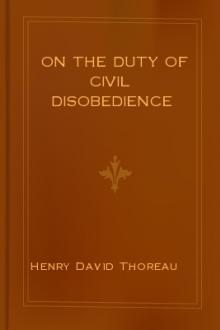Essays Henry David Thoreau (little bear else holmelund minarik .txt) 📖

- Author: Henry David Thoreau
Book online «Essays Henry David Thoreau (little bear else holmelund minarik .txt) 📖». Author Henry David Thoreau
In short, they who have not attended particularly to this subject are but little aware to what an extent quadrupeds and birds are employed, especially in the fall, in collecting, and so disseminating and planting the seeds of trees. It is the almost constant employment of the squirrels at that season, and you rarely meet with one that has not a nut in its mouth, or is not just going to get one. One squirrel-hunter of this town told me that he knew of a walnut-tree which bore particularly good nuts, but that on going to gather them one fall, he found that he had been anticipated by a family of a dozen red squirrels. He took out of the tree, which was hollow, one bushel and three pecks by measurement, without the husks, and they supplied him and his family for the winter. It would be easy to multiply instances of this kind. How commonly in the fall you see the cheek-pouches of the striped squirrel distended by a quantity of nuts! This species gets its scientific name Tamias, or the steward, from its habit of storing up nuts and other seeds. Look under a nut-tree a month after the nuts have fallen, and see what proportion of sound nuts to the abortive ones and shells you will find ordinarily. They have been already eaten, or dispersed far and wide. The ground looks like a platform before a grocery, where the gossips of the village sit to crack nuts and less savory jokes. You have come, you would say, after the feast was over, and are presented with the shells only.
Occasionally, when threading the woods in the fall, you will hear a sound as if someone had broken a twig, and, looking up, see a jay pecking at an acorn, or you will see a flock of them at once about it, in the top of an oak, and hear them break them off. They then fly to a suitable limb, and placing the acorn under one foot, hammer away at it busily, making a sound like a woodpecker’s tapping, looking round from time to time to see if any foe is approaching, and soon reach the meat, and nibble at it, holding up their heads to swallow, while they hold the remainder very firmly with their claws. Nevertheless, it often drops to the ground before the bird has done with it. I can confirm what William Bartram wrote to Wilson, the ornithologist, that “The jay is one of the most useful agents in the economy of nature, for disseminating forest trees and other nuciferous and hard-seeded vegetables on which they feed. Their chief employment during the autumnal season is foraging to supply their winter stores. In performing this necessary duty they drop abundance of seed in their flight over fields, hedges, and by fences, where they alight to deposit them in the postholes, etc. It is remarkable what numbers of young trees rise up in fields and pastures after a wet winter and spring. These birds alone are capable, in a few years’ time, to replant all the cleared lands.”
I have noticed that squirrels also frequently drop their nuts in open land, which will still further account for the oaks and walnuts which spring up in pastures, for, depend on it, every new tree comes from a seed. When I examine the little oaks, one or two years old, in such places, I invariably find the empty acorn from which they sprung.
So far from the seed having lain dormant in the soil since oaks grew there before, as many believe, it is well known that it is difficult to preserve the vitality of acorns long enough to transport them to Europe; and it is recommended in Loudon’s Arboretum, as the safest course, to sprout them in pots on the voyage. The same authority states that “very few acorns of any species will germinate after having been kept a year,” that beechmast “only retains its vital properties one year,” and the black-walnut “seldom more than six months after it has ripened.” I have frequently found that in November, almost every acorn left on the ground had sprouted or decayed. What with frost, drought, moisture, and worms, the greater part are soon destroyed. Yet it is stated by one botanical writer that “acorns that have lain for centuries, on being ploughed up, have soon vegetated.”
Mr. George B. Emerson, in his valuable Report on the Trees and Shrubs of this state, says of the pines: “The tenacity of life of the seeds is remarkable. They will remain for many years unchanged in the ground, protected by the coolness and deep shade of the forest above them. But when the forest is removed, and the warmth of the sun admitted, they immediately vegetate.” Since he does not tell us on what observation his remark is founded, I must doubt its truth. Besides, the experience of nurserymen makes it the more questionable.
The stories of wheat raised from seed buried with





Comments (0)